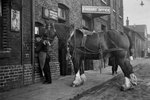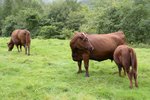
Among the Baroque horse breeds, the two most closely related are the Andalusian and Lusitano. Prized in present-day Spain and Portugal for their beauty and intelligence, they're a familiar sight to those who enjoy watching equestrian sports, such as dressage. Although recognized as separate breeds, genetically they are so similar that you must be very familiar with the breed to tell them apart by sight.
Breed Origins
Andalusians and Lusitanos originated in Europe in the area known as the Iberian Peninsula. First mention of the Andalusian horse occurs in historical records as early as the 15th century. Andalusian horses were used by bullfighters until around 1700, when the practice of bullfighting from horseback stopped in Spain, but continued in what is today Portugal. Consequently, Andalusian horses were bred for different characteristics. In Spain, they became prized as mounts for kings, nobles and warriors. In Portugal, they were fiery bullfighter's mounts. By the 1960s, the two breeds had enough differences that registries were established for each, and today they are recognized as separate breeds.
Characteristics
Andalusian horses stand approximately 15 to 16 hands tall, and are compact and muscular. They have long, flowing and thick manes and tails. The primary color is gray, but black, brown and bay sometimes are found. Lusitano horses usually are 15.2 hands high and taller, with some exceeding 16 hands. Any solid color is accepted in the breed registry, but gray, bay, black, palomino and dun are the most common colors. The body differs from the Andalusian, with a lower set tail and a more convex profile.
Temperament
Both breeds are known for their intelligence and spirit. The Andalusian tends to be more docile and calmer than the Lusitano. Because Lusitano horses were bred for bullfighting, horses were bred for boldness, courage and strength. Lusitanos can become "hot" and difficult to ride if not exercised faithfully.
Uses
Today, Lusitano and Andalusian horses are used as competition horses. The Spanish team rode Andalusians, while the Portugese team rode Lusitano horses in recent Olympic competitions. Lusitano horses often are used in equine entertainment, such as the Cavalia equestrian show, which includes several Lusitanos among its equine stars.
References
Photo Credits
-
Jupiterimages/Photos.com/Getty Images
Writer Bio
Jeanne Grunert has been a writer since 1990. Covering business, marketing, gardening and health topics, her work has appeared in the "Chicken Soup for the Soul" books, "Horse Illustrated" and many national publications. Grunert earned her Master of Arts in writing from Queens College and a Master of Science in direct and interactive marketing from New York University.



